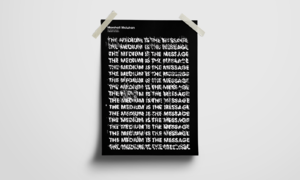TL;DR: McLuhan’s revolutionary theory directs our attention to the medium itself, rather than what it contains. |

In Understanding Media—in particular the sections that concern us: “The Medium is the Message” and “The Gadget Lover”—Marshall McLuhan develops at least two important characteristics of “media,” they:
- Extend us, and consequently,
- Change the “scale or pace or pattern” of “human affairs.”[1]
His theory develops from these two theses, so we can take them one at a time. We must also discuss the content of a medium, literacy, and transparency.
Extensions of Ourselves
McLuhan doesn’t make any clear distinctions between media and technology, and this fact extends his theory beyond what we might normally think of as “media.” In a way, media may be thought of as beneficial—especially “new media”—as it expands our reach into places we were never able to go before. McLuhan uses the example of the electric light: it is a technology that brought day into night and was able to extend our reach further into what used to be dark. This technology extended us and changed our behaviors, for good and bad.
However, McLuhan’s concern is how these extensions create a numbness, atrophy, or “self-amputation of our physical bodies” (72).[2] He argues that we become like Narcissus gazing at his reflection: “the servomechanism of his own expended or repeated image.”[3] He seems to suggest that by the continued adoption of technologies that extend ourselves, we become a reflection of the machines and, as a result, less alive. The machines become our idols, in a Biblical sense, in that we conform to them and, in a sense, worship them like gods.[4] In other words, we end up serving our gadgets:
| “ | For the man in a literate and homogenized society ceases to be sensitive to the diverse and discontinuous life of forms. […] we become what we behold.[5] | ” |
The implication seems to be, that while technology extends our reach, it also numbs a part of our physical bodies. This numbing of our central nervous system seems a necessity to McLuhan, for if we don’t, “we will die” through exposure. Therefore, we become more unconscious and apathetic, or zombie-like (this is my word, not McLuhan’s).
This is the price to be paid for any medium, particularly “electric media.”[6]
New Scale
While the narcosis—or numbness—seems to be one consequence of extending ourselves through or gadgets, that may not be the only effect, especially when the technologies are adopted as quickly as they are today. As stated above, any medium or technology changes the “scale or pace or pattern” of the individual, but also affects the political community. McLuhan’s analysis of media seems to default on the side of politics. While numb, we are controlled and homogenized by technology: “for any medium has the power of imposing its own assumption on the unwary.”[7] When we become used to the demands of the technology—when we are literate, we conform to the demands of the technology by acting in “uniform and continuous patterns”—we no longer have to think about the technology at all. It has become transparent for practical purposes. In fact, we might have lost our ability to critically judge the technology since it has become so much a part of our lives. After all, worshippers do not question their gods.
The American stake in literacy as a technology or uniformity applied to every level of education, government, industry, social life is totally threatened by the electric technology. The threat of Stalin or Hitler was external. The electric technology is within the gates, and we are numb, deaf, blind, and mute about its encounter with the Gutenberg technology, on and through which the American way of life was formed.[8]
And he wasn’t even talking about digital media in 1964.
In addition, McLuhan points out that we are often distracted by discussions of content, so we fail to look at medium at all.[9] Content “blinds us to the character of the medium” which can then control the scale or pace or pattern of human affairs.[9] Content, for McLuhan, is a distraction from what we should be paying attention to: the technology itself—to “understanding the media that extend us and raise these wars within and without us.”[7]
What Is to Be Done?
The answer to breaking the Narcissistic cybernetic loop of numbness seems to lie with the expression of the “serious artist.”[10] For example, Cubism drops the illusion of verisimilitude and challenges the viewer to look at the painting. It’s no longer what the painting was about, but an awareness of the medium. Resistance may also have something to do with the non-conformist—the underprivileged or illiterate. Perhaps it is like Mailer’s Hipster.
Notes
- ↑ McLuhan, Marshall (2003) [1964]. "The Medium Is the Message". In Wardrip-Fruin, Noah; Montfort, Nick. The New Media Reader. Cambridge: The MIT Press. p. 203.
- ↑ McLuhan, Marshall (2002) [1964]. "The Gadget Lover: Narcissus as Narcosis". In Spiller, Neil. Cyber Reader: Critical Writing for the Digital Era. Phaidon Press. ISBN 0714840718.
- ↑ McLuhan 2002, p. 70.
- ↑ McLuhan 2002, pp. 72–73.
- ↑ McLuhan 2003, p. 208.
- ↑ McLuhan 2002, p. 74.
- ↑ 7.0 7.1 McLuhan 2003, p. 206.
- ↑ McLuhan 2003, p. 207.
- ↑ 9.0 9.1 McLuhan 2003, p. 203.
- ↑ McLuhan 2003, p. 207–208.
